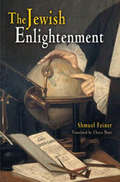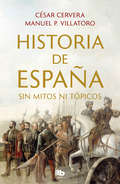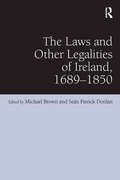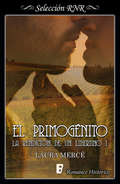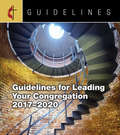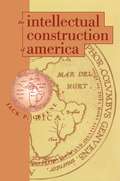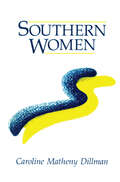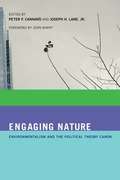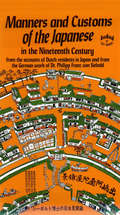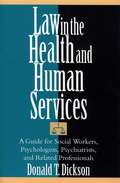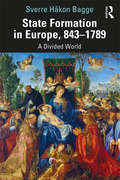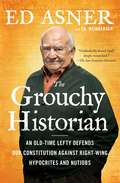- Table View
- List View
The Jewish Enlightenment
by Shmuel Feiner Chaya NaorAt the beginning of the eighteenth century most European Jews lived in restricted settlements and urban ghettos, isolated from the surrounding dominant Christian cultures not only by law but also by language, custom, and dress. By the end of the century urban, upwardly mobile Jews had shaved their beards and abandoned Yiddish in favor of the languages of the countries in which they lived. They began to participate in secular culture and they embraced rationalism and non-Jewish education as supplements to traditional Talmudic studies. The full participation of Jews in modern Europe and America would be unthinkable without the intellectual and social revolution that was the Haskalah, or Jewish Enlightenment.Unparalleled in scale and comprehensiveness, The Jewish Enlightenment reconstructs the intellectual and social revolution of the Haskalah as it gradually gathered momentum throughout the eighteenth century. Relying on a huge range of previously unexplored sources, Shmuel Feiner fully views the Haskalah as the Jewish version of the European Enlightenment and, as such, a movement that cannot be isolated from broader eighteenth-century European traditions. Critically, he views the Haskalah as a truly European phenomenon and not one simply centered in Germany. He also shows how the republic of letters in European Jewry provided an avenue of secularization for Jewish society and culture, sowing the seeds of Jewish liberalism and modern ideology and sparking the Orthodox counterreaction that culminated in a clash of cultures within the Jewish community. The Haskalah's confrontations with its opponents within Jewry constitute one of the most fascinating chapters in the history of the dramatic and traumatic encounter between the Jews and modernity.The Haskalah is one of the central topics in modern Jewish historiography. With its scope, erudition, and new analysis, The Jewish Enlightenment now provides the most comprehensive treatment of this major cultural movement.
Churches Of Eastern Christendom
by KiddFirst published in 2006. Routledge is an imprint of Taylor & Francis, an informa company.
Economics of Business Valuation
by Patrick L. AndersonFor decades, the market, asset, and income approaches to business valuation have taken center stage in the assessment of the firm. This book brings to light an expanded valuation toolkit, consisting of nine well-defined valuation principles hailing from the fields of economics, finance, accounting, taxation, and management. It ultimately argues that the "value functional" approach to business valuation avoids most of the shortcomings of its competitors, and more correctly matches the actual motivations and information set held by stakeholders. Much of what we know about corporate finance and mathematical finance derives from a narrow subset of firms: publicly traded corporations. The value functional approach can be readily applied to both large firms and companies that do not issue publicly traded stocks and bonds, cannot borrow without constraints, and often rely upon entrepreneurs to both finance and manage their operations. With historical side notes from an international set of sources and real-world exemplars that run throughout the text, this book is a future-facing resource for scholars in economics and finance, as well as the academically minded valuation practitioner.
Historia de España sin mitos ni tópicos
by César Cervera Manuel P. VillatoroUn recorrido didáctico y rico por los grandes hechos y personajes que marcaron la historia de España. Los mitos han perseguido a España desde que Escipión Emiliano sitió Numancia. Durante los siguientes siglos se han esgrimido una retahíla de falacias sobre este país que, a golpe de repetirse, han forjado la llamada Leyenda Negra. Este libro se enfrenta a todas ellas. Desde la idea de que la brutalidad campó a sus anchas a partir del siglo XVI, hasta la que muestra a los conquistadores como bárbaros sedientos de sangre. Con la veracidad y el rigor de los datos por estandarte, y bajo la premisa de buscar siempre una divulgación amena, los periodistas César Cervera y Manuel Villatoro abordan en estas páginas las gestas más reconocidas de las tropas españolas a lo largo de dos mil años, las peripecias más llamativas de los monarcas que han dirigido este país o, entre otras muchas cosas, los hitos más destacados de su pasado. Un paseo rico y fascinante para acercarnos un poco más al relato más apasionante de todos: el de nuestra historia. Algunos lectores ilustres han dicho...«Un ramillete de artículos que responden a la máxima horaciana de enseñar deleitando (prodesse et delectare). ¿Qué más se puede desear?»Juan Eslava Galán «César Cervera y Manu Villatoro convierten la historia de España en noticia de portada que no te puedes perder. ¡Imprescindible!»Isabel San Sebastián «Estos jóvenes periodistas han conseguido contar la historia de España como si fuera el mejor de los reportajes: riguroso, ágil, veraz, informativo y ameno.»Antonio Pérez Henares
Predicting Presidential Elections and Other Things, Second Edition
by Ray C. FairWhat do the following events have in common? In 2000, the election between George W. Bush and Al Gore was a virtual tie. The 1989 and 1990 vintages have turned out to be two of the best ever for Bordeaux wines. In 2001, the Federal Reserve lowered the interest rate eleven times. The decade of the 1970s was one of the worst on record for U.S. inflation. In 2001, the author of this book, at age 59, ran a marathon in 3 hours and 30 minutes, but should have been able to do it in 3 hours and 15 minutes. This book shows clearly and simply how these diverse events can be explained by using the tools of the social sciences and statistics. It moves from a discussion of formulating theories about real world phenomena to lessons on how to analyze data, test theories, and make predictions. Through the use of a rich array of examples, the book demonstrates the power and range of social science and statistical methods. In addition to “big” topics—presidential elections, Federal Reserve behavior, and inflation—and “not quite so big” topics—wine quality—the book takes on questions of more direct, personal interest. Who of your friends is most likely to have an extramarital affair? How important is class attendance for academic performance in college? How fast can you expect to run a race or perform some physical task at age 55, given your time at age 30? (In other words, how fast are you slowing down?) As the author works his way through an incredibly broad range of questions and topics, demonstrating the usefulness of statistical theory and method, he gives the reader a new way of thinking about many age-old concerns in public and private life.
The Laws and Other Legalities of Ireland, 1689-1850
by Seán Patrick DonlanWhile Irish historical writing has long been in thrall to the perceived sectarian character of the legal system, this collection is the first to concentrate attention on the actual relationship that existed between the Irish population and the state under which they lived from the War of the Two Kings (1689-1691) to the Great Famine (1845-1849). Particular attention is paid to an understanding of the legal character of the state and the reach of the rule of law, with contributors addressing such themes as: how law was made and put into effect; how ordinary people experienced the law and social regulations; how Catholics related to the legal institutions of the Protestant confessional state; and how popular notions of legitimacy were developed. These themes contribute to a wider understanding of the nature of the state in the long eighteenth century and will therefore help to situate the study of Irish society into the mainstream of English and European social history.
A History of New York
by Washington IrvingPurchase of this book includes free trial access to www. million-books. com where you can read more than a million books for free. This is an OCR edition with typos. Excerpt from book: BOOK I. CONTAINING DIVERS INGENIOUS THEORIES AVD PHILOSOPHIC SPECULATIONS, CONCERNING THE CREATION AND POPULATION OF THE WORLD, AS CONNECTED WITH THE HISTORY OF NEW-YORK. CHAPTER I. Description of the World. According to the best authorities, theworld iu which we dwell is a huge, opaque, reflecting, inanimate mass, floating in the vast ethereal ocean of infinite space. It has the form of an orange, being an oblate spheroid, curiously flattened at opposite parts, for the insertion of two imaginary poles, which are supposed to penetrate and unite at the centre; thus forming an axis on which the mighty orange turns with a regular diurnal revolution. The transitions of light and darkness, whence proceed the alternations of day and night, are produced by this diurnal revolution successively pre- 32 DERSCRIPTION OF THE WORLD. tenting the different parts of the earth to the rays of the sun. The latter is, according to the best, that is to say, the latest accounts, a luminous or fiery body, of a prodigious magnitude, from which this world is driven by a centrifugal or repelling power, and to which it is drawn by a centripetal or attractive force; otherwise called the attraction of gravitation; the combination, or rather the counteraction of these two opposing impulses pBoducing a circular and annual revolution. Hence result the different seasons of the year, viz. spring, summer, autumn, and winter. This I believe to be the most approved modern theory on the subject?though there be many philosophers who have entertained very different opinions; some, too, of them entitled to much deference from their great antiquity and illustrious characters. Thus it was advanced by some of the ancient sages, that the earth was an extended plain, supported by vast pillars; and by . . .
El primogénito (La rendición de un libertino #Volumen 1)
by Laura MercéPrimera entrega de la trilogía «La rendición de un libertino». ¿Puede un pendenciero y redomado libertino transformarse en un hombre nuevo, cabal y responsable? Diego Ibáñez, a pesar de su hidalguía y sentido del honor, y pertenecer a la alta burguesía, no puede evitar ser el libertino que todos ven en él. Ser un verdadero donjuán desde la adolescencia lo lleva a ser protagonista de sucesivos escándalos amorosos y peligrosos duelos. Y esto genera un constante dolor de cabeza para toda su familia, más aún cuando es el heredero de las bodegas y el encarrilarlo por la buena senda es imposible de lograr. Durante un viaje a Inglaterra, Diego conoce a Brunilda, una mujer que logra lo que ninguna otra: que caiga rendido ante ella. Sin embargo, sus dotes seductoras no serán suficientes para ella, quien ya está comprometida con otro hombre. El tiempo seguirá su curso, pero Diego no se olvida de ella. Así, cumplirá con la promesa hecha a su padre de ser un hombre de provecho y buscar una digna esposa. Pero... ¿podrá un sujeto extravagante como él, acostumbrado a poner en relieve su incontenible vitalidad sensual y mantener relaciones con varias amantes, cambiar de la noche a la mañana y transformarse en alguien que nunca imaginó llegar a ser?
Gatehaven: A Novel
by Molly Noble BullGatehaven by Molly Noble Bull is a Christian Gothic historical novel set in a haunting mansion in the north of England where Ian Colquhoun and Shannon Aimee battle a Frenchman with dark secrets--spiritual warfare vs. the occult. Will they learn enough about God’s words to defend themselves and others or will evil overcome them? Gatehaven is the 2013 Creation House Fiction Writing Contest Winner.
Guidelines for Leading Your Congregation 2017-2020: For Each Ministry of Your Church
by General Board Of Discipleship"The local church is to minister to persons in the community where the church is located, to provide appropriate training and nurture to all, to cooperate in ministry with other local churches, to defend God's creation and live as an ecologically responsible community, and to participate in the worldwide mission of the church." — Book of Discipline 2012 ¶202 The twenty-six Guidelines for Leading Your Congregation 2017-2020, one for each ministry area, cover church leadership areas, as well as areas focused on nurture, outreach, and witness. The booklets are tools that get new lay leaders off to a good start and as a reference resource for all lay leaders. Each booklet includes the basic "job description" for the leader as well as practical "how-to" information important to implementing ministry effectively. Brief and to the point making it a perfect resource for the busy, but spirit-led leader. eBook Edition allows you download a digital file of all 26 Guidelines to your eReader for personal use. Include Guidelines included in Sets and sold separately are: Adult Ministries Advocates for Inclusiveness Children's Ministries Christian Education Church Council Church Historian Church & Society Communications Evangelism Family Ministries Finance Higher Education & Campus Ministry Lay Leader/Lay Member Men's Ministries Ministries With Young People Mission Nominations & Leadership Development Pastor Pastor-Parish Relations Scouting & Civil Youth-Serving Ministry Small Group Ministries Small Membership Church Stewardship Trustees Women's Ministries Worship
The Intellectual Construction of America
by Jack P. GreeneJack Greene explores the changing definitions of America from the time of Europe's first contact with the New World through the establishment of the American republic. Challenging historians who have argued that colonial American societies differed little from those of early modern Europe, he shows that virtually all contemporary observers emphasized the distinctiveness of the new worlds being created in America. Rarely considering the high costs paid by Amerindians and Africans in the construction of those worlds, they cited the British North American colonies as evidence that America was for free people a place of exceptional opportunities for individual betterment and was therefore fundamentally different from the Old World. Greene suggests that this concept of American societies as exceptional was a central component in their emerging identity. The success of the American Revolution helped subordinate Americans' long-standing sense of cultural inferiority to a more positive sense of collective self that sharpened and intensified the concept of American exceptionalism.
The Writings of David Thompson, Volume 2
by William E. MoreauDavid Thompson's Travels is one of the finest early expressions of the Canadian experience. The work is not only the account of a remarkable life in the fur trade but an extended meditation on the land and Native peoples of western North America. The second in a planned three volumes of Thompson's writings, this edition completes the great surveyor and fur trader's spirited autobiographical narrative. In the 1848 Travels, Thompson describes his most enduring historical legacy - the extension of the fur trade across the Continental Divide between 1807 and 1812. During these years he established several Nor'wester trading posts, made contact with the tribal peoples of the Columbia Plateau, and tirelessly mapped the lands he traversed, all the time striving westward toward the Pacific. The tale culminates with Thompson's historic arrival at the mouth of the Columbia in July 1811. Like its companion Volume 1, this work presents an entirely new transcription by William Moreau of Thompson's manuscript, and is accompanied by an introductory essay placing the author in his historical and intellectual context. Extensive critical annotations, a biographical appendix, and historical and modern maps, make this the definitive collection of Thompson's works, and bring one of North America's most important travelers and surveyors to a new generation of readers.
Southern Women
by Caroline M. DillmanFirst published in 1988. Routledge is an imprint of Taylor & Francis, an informa company.
Engaging Nature
by Peter F. Cannavò John Barry Joseph H. Lane Jr.Contemporary environmental political theory considers the implications of the environmental crisis for such political concepts as rights, citizenship, justice, democracy, the state, race, class, and gender. As the field has matured, scholars have begun to explore connections between Green Theory and such canonical political thinkers as Plato, Machiavelli, Locke, and Marx. The essays in this volume put important figures from the political theory canon in dialogue with current environmental political theory. It is the first comprehensive volume to bring the insights of Green Theory to bear in reinterpreting these canonical theorists.Individual essays cover such classical figures in Western thought as Aristotle, Hume, Rousseau, Mill, and Burke, but they also depart from the traditional canon to consider Mary Wollstonecraft, W. E. B. Du Bois, Hannah Arendt, and Confucius. Engaging and accessible, the essays also offer original and innovative interpretations that often challenge standard readings of these thinkers. In examining and explicating how these great thinkers of the past viewed the natural world and our relationship with nature, the essays also illuminate our current environmental predicament.Essays onPlato Aristotle Niccolò Machiavelli Thomas Hobbes John Locke David Hume Jean-Jacques Rousseau Edmund Burke Mary Wollstonecraft John Stuart Mill Karl Marx W. E. B. Du Bois Martin Heidegger Hannah Arendt Confucius ContributorsSheryl D. Breen, W. Scott Cameron, Peter F. Cannavò, Joel Jay Kassiola, Joseph H. Lane Jr. Timothy W. Luke, John M. Meyer, Özgüç Orhan, Barbara K. Seeber, Francisco Seijo, Kimberly K. Smith, Piers H. G. Stephens, Zev Trachtenberg, Andrew Valls, Harlan Wilson
Manners and Customs of the Japanese in the Nineteenth Century
by Terence Barrow Philipp Franz von SieboldManners and Customs of the Japanese in the Nineteenth Century is a delightful account of the Japanese of Tokugawa Japan.This unique handbook of Japanese manners, customs, history, and singular happenings was published in New York in 1841. Based on the firsthand observations of Dr. Philipp Franz von Siebold of the Dutch trading port Deshima in the years 1823-29, as well as on Spanish, Portuguese, German, and English records of early Japan, it provided us with a very rare picture of what Japan was like in the final years of its feudal period.Dr. von Siebold, the chief contributor, was attached to the Deshima post as a medial adviser and traveled within Japan, befriending and teaching many Japanese who were later to distinguish themselves in Western scientific knowledge. An indiscretion in accepting a map of Japan brought about his banishment by the Edo government and forced return to his native Germany.No collection of books on Japan is complete without a copy of Manners and Customs of the Japanese. It is here reprinted in its entirety from the original edition. Long submerged and virtually forgotten after a century of neglect, it is now made available for a new generation of readers.
Manners and Customs of the Japanese in the Nineteenth Century
by Terence Barrow Philipp Franz von SieboldManners and Customs of the Japanese in the Nineteenth Century is a delightful account of the Japanese of Tokugawa Japan.This unique handbook of Japanese manners, customs, history, and singular happenings was published in New York in 1841. Based on the firsthand observations of Dr. Philipp Franz von Siebold of the Dutch trading port Deshima in the years 1823-29, as well as on Spanish, Portuguese, German, and English records of early Japan, it provided us with a very rare picture of what Japan was like in the final years of its feudal period.Dr. von Siebold, the chief contributor, was attached to the Deshima post as a medial adviser and traveled within Japan, befriending and teaching many Japanese who were later to distinguish themselves in Western scientific knowledge. An indiscretion in accepting a map of Japan brought about his banishment by the Edo government and forced return to his native Germany.No collection of books on Japan is complete without a copy of Manners and Customs of the Japanese. It is here reprinted in its entirety from the original edition. Long submerged and virtually forgotten after a century of neglect, it is now made available for a new generation of readers.
Manners and Customs of the Japanese in the Nineteenth Century
by Terence Barrow Philipp Franz von SieboldManners and Customs of the Japanese in the Nineteenth Century is a delightful account of the Japanese of Tokugawa Japan.This unique handbook of Japanese manners, customs, history, and singular happenings was published in New York in 1841. Based on the firsthand observations of Dr. Philipp Franz von Siebold of the Dutch trading port Deshima in the years 1823-29, as well as on Spanish, Portuguese, German, and English records of early Japan, it provided us with a very rare picture of what Japan was like in the final years of its feudal period.Dr. von Siebold, the chief contributor, was attached to the Deshima post as a medial adviser and traveled within Japan, befriending and teaching many Japanese who were later to distinguish themselves in Western scientific knowledge. An indiscretion in accepting a map of Japan brought about his banishment by the Edo government and forced return to his native Germany.No collection of books on Japan is complete without a copy of Manners and Customs of the Japanese. It is here reprinted in its entirety from the original edition. Long submerged and virtually forgotten after a century of neglect, it is now made available for a new generation of readers.
The Ashland Tragedy: Murder, Mob & a Militia in Kentucky (True Crime)
by E. Joe CastleThis true crime history recounts the notorious nineteenth-century murder of three Kentucky children and the shocking aftermath once arrests were made. On Christmas Eve 1881, a horrible crime shook the small town of Ashland, Kentucky, and captivated the entire nation. Three children were brutally murdered and their house set ablaze. Nothing in the small town&’s past had prepared it for what followed. Three men were convicted of the crimes, and two were sentenced to death. But the murderers were protected by the governor&’s untrained militia, which would eventually turn their guns on Ashland&’s innocent citizens. Much of these events were recorded at the time by James Morgan Huff, founder of the Ashland Republican newspaper, in a booklet titled The Ashland Tragedy. Now author and Ashland native H.E. &“Joe&” Castle builds on Huff&’s work to reveal the full, true story of one of the darkest chapters in the history of Kentucky.
The French Revolution: From its Origins to 1793
by Georges LefebvreInternationally renowned as the greatest authority on the French Revolution, Georges Lefebvre combined impeccable scholarship with a lively writing style. His masterly overview of the history of the French Revolution has taken its rightful place as the definitive account. A vivid narrative of events in France and across Europe is combined with acute insights into the underlying forces that created the dynamics of the revolution, as well as the personalities responsible for day-to-day decisions during this momentous period.
Awesome America: Everything You Ever Wanted to Know About the History, People, and Culture
by The Editors of Time For KidsFor the first time ever, in a single indispensable reference volume, TIME For Kids Awesome America offers 8-12 year olds a fun, fact-filled, and photographic overview of the people, places, and events that have made America awesome. From America's early history all the way to present day, kids will learn about what it was like to grow up in the 1700's, 1800's, 1900's and today and will find out all about the inventions, innovations, and movements great American's have created over the years. Structured for both dip-in reference and longer-form reading, Awesome America is organized into 14 thematic sections, each comprised of bite-sized articles, engaging factoid sidebars, colorful charts, graphics and interactive quizzes for easy school report or homework helper reference.The 14 sections include: Our BeginningOur GovernmentOur PresidentsAll 50 States and MoreThe LandThe Great Melting PotMoments that Changed AmericaCivil Rights MovementsGreat AmericansGrowing Up in AmericaAmerica's Role in the WorldOur Home: Grown Gifts to the WorldOne-Of-A-Kind Experiences (only found on American soil)Year-By-Year A Timeline (comprehensive visual timeline pre-Columbus through the present)Plus, a complete Glossary and Index
Law in the Health and Human Services
by Donald T. DicksonProfessor Dickson provides students with examples of a legal way of thinking about significant issues in social policy. This book can be used in policy and practice courses in the fields of mental health, child welfare, the family, developmental and physical disabilities, and professional ethics. Provides excellent selection of relevant court decisions along with clearly articulated questions and issues for discussion.
State Formation in Europe, 843–1789: A Divided World
by Sverre BaggeState Formation in Europe, 843–1789 follows the formation and development of the European state from the division of the Carolingian Empire to the French Revolution. The book’s primary focus is on Europe’s patterns of internal and external development in comparison to political organization in other parts of the world. By analysing Europe as a single unit, rather than dividing it into nation states, it reveals the broader historical connections within the Continent. Bagge takes the reader through a discussion of how kingdoms evolved into states, introducing the influence of the Church and the town on these state structures. The relationship between state, Church and town is traced to explain how these different power struggles played out and why the territorial state became the dominate form of organization. Finally, the book clarifies why Europe developed in this way and the global consequences of this development. By observing Europe through the perspective of the rest of the world, readers gain insight into trends common to the whole Continent while crossing the traditional border between the Middle Ages and early modern period. This book is essential reading for students studying medieval and early modern political history, state formation and Europe in a global context.
The Grouchy Historian: An Old-Time Lefty Defends Our Constitution Against Right-Wing Hypocrites and Nutjobs
by Ed Asner Ed. WeinbergerIn the tradition of Al Franken and Michael Moore, Ed Asner—a.k.a. Lou Grant from The Mary Tyler Moore Show—reclaims the Constitution from the right-wingers who think that they and only they know how to interpret it.Ed Asner, a self-proclaimed dauntless Democrat from the old days, figured that if the right-wing wackos are wrong about voter fraud, Obama’s death panels, and climate change, they are probably just as wrong about what the Constitution says. There’s no way that two hundred-plus years later, the right-wing ideologues know how to interpret the Constitution. On their way home from Philadelphia the people who wrote it couldn’t agree on what it meant. What was the president’s job? Who knew? All they knew was that the president was going to be George Washington and as long as he was in charge, that was good enough. When Hamilton wanted to start a national bank, Madison told him that it was unconstitutional. Both men had been in the room when the Constitution was written. And now today there are politicians and judges who claim that they know the original meaning of the Constitution. Are you kidding? In The Grouchy Historian, Ed Asner leads the charge for liberals to reclaim the Constitution from the right-wingers who use it as their justification for doing whatever terrible thing they want to do, which is usually to comfort the comfortable and afflict the afflicted. It’s about time someone gave them hell and explained that progressives can read, too.
The Summer of 1787
by David O. StewartThe successful creation of the Constitution is a suspense story. The Summer of 1787 takes us into the sweltering room in which delegates struggled for four months to produce the flawed but enduring document that would define the nation -- then and now. George Washington presided, James Madison kept the notes, Benjamin Franklin offered wisdom and humor at crucial times. The Summer of 1787 traces the struggles within the Philadelphia Convention as the delegates hammered out the charter for the world's first constitutional democracy. Relying on the words of the delegates themselves to explore the Convention's sharp conflicts and hard bargaining, David O. Stewart lays out the passions and contradictions of the often painful process of writing the Constitution. It was a desperate balancing act. Revolutionary principles required that the people have power, but could the people be trusted? Would a stronger central government leave room for the states? Would the small states accept a Congress in which seats were alloted according to population rather than to each sovereign state? And what of slavery? The supercharged debates over America's original sin led to the most creative and most disappointing political deals of the Convention. The room was crowded with colorful and passionate characters, some known -- Alexander Hamilton, Gouverneur Morris, Edmund Randolph -- and others largely forgotten. At different points during that sultry summer, more than half of the delegates threatened to walk out, and some actually did, but Washington's quiet leadership and the delegates' inspired compromises held the Convention together. In a country continually arguing over the document's original intent, it is fascinating to watch these powerful characters struggle toward consensus -- often reluctantly -- to write a flawed but living and breathing document that could evolve with the nation.
